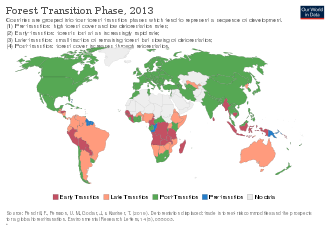Forest transition
Forest transition refers to the temporal change from a net loss to a net gain in a region's forest area. This concept is crucial in understanding the dynamics of forest cover changes over time, which can be influenced by various factors including economic development, agricultural shifts, and conservation policies. The forest transition theory posits that as countries develop economically, they transition from periods of forest depletion and degradation to periods of forest recovery and expansion.
Overview
The phenomenon of forest transition can be observed in two primary pathways. The first pathway is economic development driven, where increases in income and advances in technology lead to agricultural intensification and urbanization, reducing the reliance on forest land for livelihood. This leads to a decrease in deforestation rates and allows for the natural regeneration of forests or afforestation efforts to take place. The second pathway is through forest scarcity, where the degradation of forests and the scarcity of forest resources lead to increased conservation efforts and the implementation of policies aimed at reforesting lands.
Stages of Forest Transition
The process of forest transition can be broadly divided into four stages:
- Pre-transition, characterized by high forest cover and low deforestation rates.
- Transition initiation, where deforestation rates begin to increase due to agricultural expansion and extraction of forest resources.
- Transition, marked by the highest rates of deforestation and forest degradation.
- Post-transition, where deforestation rates decline, and forest cover stabilizes or increases due to natural regeneration or reforestation efforts.
Factors Influencing Forest Transition
Several factors can influence the occurrence and pace of forest transition, including:
- Economic development: As countries develop, the shift towards a service-oriented economy and improvements in agricultural productivity can reduce the pressure on forests.
- Policies and governance: Effective forest management policies, land use regulations, and conservation initiatives can facilitate forest recovery.
- Societal values: Changes in societal values towards environmental conservation and sustainability can support forest transition.
- Technological advances: Innovations in agriculture and forestry practices can reduce the need for new deforestation and promote more efficient use of land.
Examples of Forest Transition
Several countries have experienced forest transitions. For example, in the late 19th and early 20th centuries, countries like the United States and parts of Western Europe underwent forest transitions as they moved towards industrialized economies and implemented conservation policies. More recently, countries like Vietnam and China have shown signs of forest transition through reforestation and afforestation efforts driven by government policies and economic shifts.
Challenges and Criticisms
While the concept of forest transition offers a hopeful perspective on forest recovery, it is not without challenges and criticisms. Some argue that the new forests created through afforestation may lack the biodiversity of the original forests they replace. Others point out that forest transitions in one region might lead to deforestation in another, as agricultural and timber demands are shifted elsewhere, a phenomenon known as leakage.
Conclusion
Forest transition is a complex process influenced by a multitude of factors. Understanding these dynamics is crucial for developing strategies that promote sustainable forest management and conservation. As the world continues to grapple with the challenges of deforestation and climate change, the concept of forest transition provides a framework for envisioning and working towards a future where forests are restored and preserved for future generations.
This article is a environment-related stub. You can help WikiMD by expanding it!
Transform your life with W8MD's budget GLP-1 injections from $125.
W8MD offers a medical weight loss program to lose weight in Philadelphia. Our physician-supervised medical weight loss provides:
- Most insurances accepted or discounted self-pay rates. We will obtain insurance prior authorizations if needed.
- Generic GLP1 weight loss injections from $125 for the starting dose.
- Also offer prescription weight loss medications including Phentermine, Qsymia, Diethylpropion, Contrave etc.
NYC weight loss doctor appointments
Start your NYC weight loss journey today at our NYC medical weight loss and Philadelphia medical weight loss clinics.
- Call 718-946-5500 to lose weight in NYC or for medical weight loss in Philadelphia 215-676-2334.
- Tags:NYC medical weight loss, Philadelphia lose weight Zepbound NYC, Budget GLP1 weight loss injections, Wegovy Philadelphia, Wegovy NYC, Philadelphia medical weight loss, Brookly weight loss and Wegovy NYC
|
WikiMD's Wellness Encyclopedia |
| Let Food Be Thy Medicine Medicine Thy Food - Hippocrates |
Medical Disclaimer: WikiMD is not a substitute for professional medical advice. The information on WikiMD is provided as an information resource only, may be incorrect, outdated or misleading, and is not to be used or relied on for any diagnostic or treatment purposes. Please consult your health care provider before making any healthcare decisions or for guidance about a specific medical condition. WikiMD expressly disclaims responsibility, and shall have no liability, for any damages, loss, injury, or liability whatsoever suffered as a result of your reliance on the information contained in this site. By visiting this site you agree to the foregoing terms and conditions, which may from time to time be changed or supplemented by WikiMD. If you do not agree to the foregoing terms and conditions, you should not enter or use this site. See full disclaimer.
Credits:Most images are courtesy of Wikimedia commons, and templates, categories Wikipedia, licensed under CC BY SA or similar.
Contributors: Prab R. Tumpati, MD


